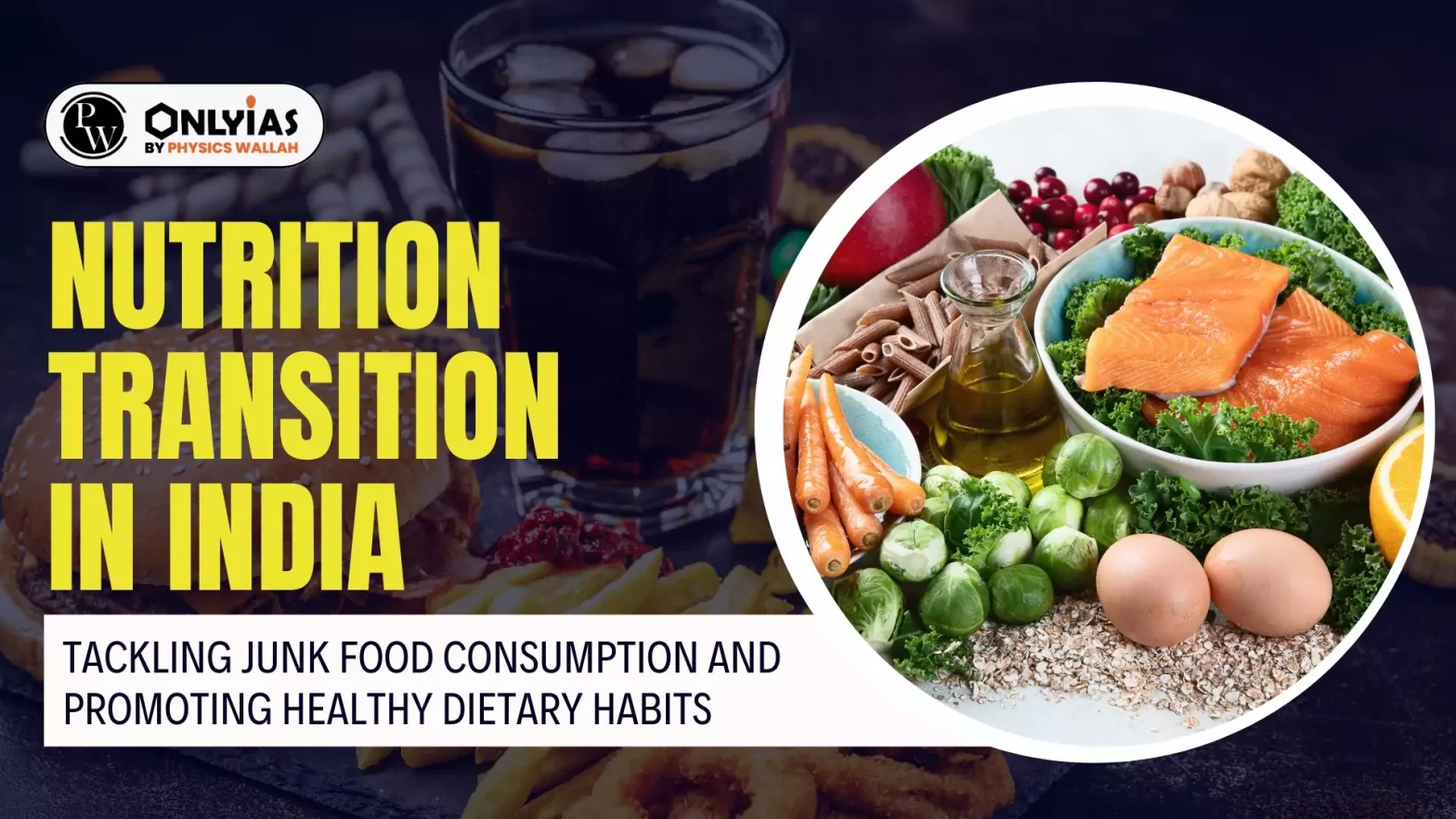Context
India, like in many other countries, is undergoing a major “nutrition transition”.
Nutrition Transition in India and the Rise of Junk Food Consumption
- Shift in Dietary Patterns: India is undergoing a significant nutrition transition marked by a shift from traditional, fiber-rich diets to processed, high-calorie Western-style diets, coinciding with economic progress and urbanization.
- Rise of Junk Food Consumption: Rapid economic growth and urbanization have led to increased consumption of packaged and processed foods, termed “junk foods,” which are low in nutrients but high in calories, fats, salt, and sugar.
- Examples of such junk or high in fats, salts and sugar (HFSS) foods include cookies, cakes, chips, namkeen, instant noodles, sugary drinks, frozen meals, canned fruits, Indian sweets, and bakery products.
- Health Implications: Scientific evidence links junk food consumption to weakened immune systems, hypertension, diabetes, obesity, and increased cancer risk, contributing to the rise of lifestyle diseases in India.
- Indian Council of Medical Research (ICMR) study published in 2023 estimates that in India 11% has diabetes, 35% is hypertensive and almost 40% are suffering from abdominal obesity.
- Advertising Impact on Indian Diets: A significant factor to consider while analyzing the evolving dietary habits of Indians is the influence of aggressive advertising to promote “tasty” and “affordable” comfort foods, particularly aimed at younger consumers.
- According to a survey conducted by the Centre for Science and Environment (CSE), 93% of children ate food that was packaged, 68% drank packaged sweetened beverages more than once a week, and 53% ate these foods at least once a day.
- Growth of Ultra- Processed Food Industry: The ultra-processed food industry in India has expanded at a compound annual growth rate of 13.37% between 2011 and 2021. Moreover, India’s food processing industry is predicted to be worth $535 billion by 2025-26.
Enroll now for UPSC Online Course
Indian Government’s Response to Junk Food and Public Health Concerns
- Supreme Court Ruling: The Supreme Court of India emphasized the right to life under Article 21 of the Constitution concerning public health hazards posed by unsafe food.
- Government Initiatives: Government initiatives like Eat Right India, the Fit India Movement, and Poshan 2.0 prioritize promoting healthy foods and active lifestyles.
- Regulatory Measures: FSSAI regulations restrict the sale of High in Fats, Salts, and Sugars (HFSS) foods in school environments.
- Call to Withdraw Misleading Health Drink Ads: National Commission for Protection of Child Rights also issued notice to a health drink giant to evaluate and withdraw all misleading advertisements, packaging and labels that brand the product as a “health drink”.
- Concerns: Despite policy intentions, effective implementation remains a challenge, necessitating further action.
Strategies for Curbing Junk Food Consumption in India
- Clear Definition of HFSS Foods: Define HFSS foods to enable better implementation of food safety regulations, focusing on protecting children from harmful impacts.
- Strengthening of Compliance: Strengthen compliance through stricter enforcement by institutions like the National Commission for Protection of Child Rights.
- Front-of-Pack Labeling (FOPL): Implement FOPL, such as warning labels indicating high salt content, to facilitate informed consumer choices.
- Indian Nutrition Rating (INR): Introduce INR based on nutritional profiles to guide consumers, addressing concerns of potential loopholes and voluntary compliance.
- Voluntary Regulations: Moreover, regulations are voluntary until a period of four years from the date of final notification of the regulations.
- Subsidizing Healthy Foods: Develop policies offering subsidies for healthy foods like whole foods, millets, fruits, and vegetables to improve availability and affordability.
Way Forward: Promoting Healthy Dietary Habits in India
- Behavioral Change Campaigns: Launch multimedia campaigns targeting children and young adults to promote healthy dietary habits.
- Utilize initiatives like “vocal for local” to endorse local and seasonal produce and traditional foods, alongside educational efforts on balanced diets.
- Promoting Healthy Choices: Engage social media influencers to mainstream discussions about the health risks of junk foods and promote mindful eating practices.
- Call to Action: Acknowledge the urgency of transitioning to healthier diets and fostering public demand for nutritious foods.
- Empowering Informed Choices: Embrace a “Jan Andolan” or people’s movement for healthy and diverse diets, accompanied by sincere policy interventions to empower informed food choices.
Conclusion
Addressing the challenges posed by unhealthy dietary habits in India requires a multifaceted approach encompassing regulatory measures, consumer awareness campaigns, and policy interventions to promote access to and consumption of nutritious foods.
Also Read: India’s Growing Obesity Challenge: A Lancet Study
![]() 24 Apr 2024
24 Apr 2024

